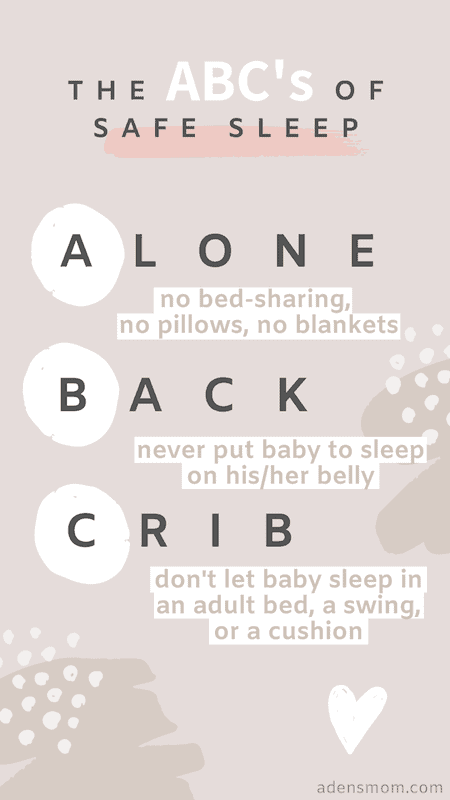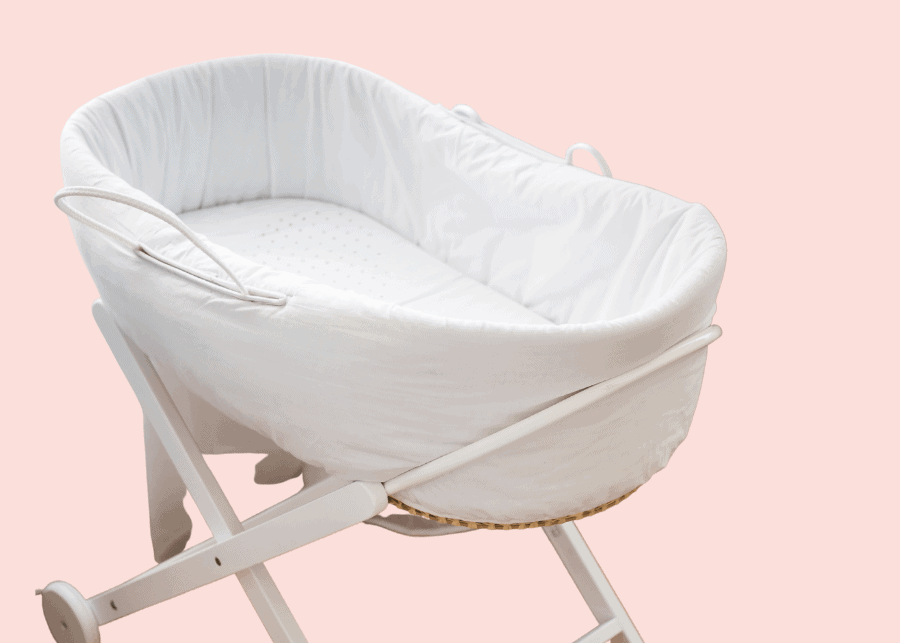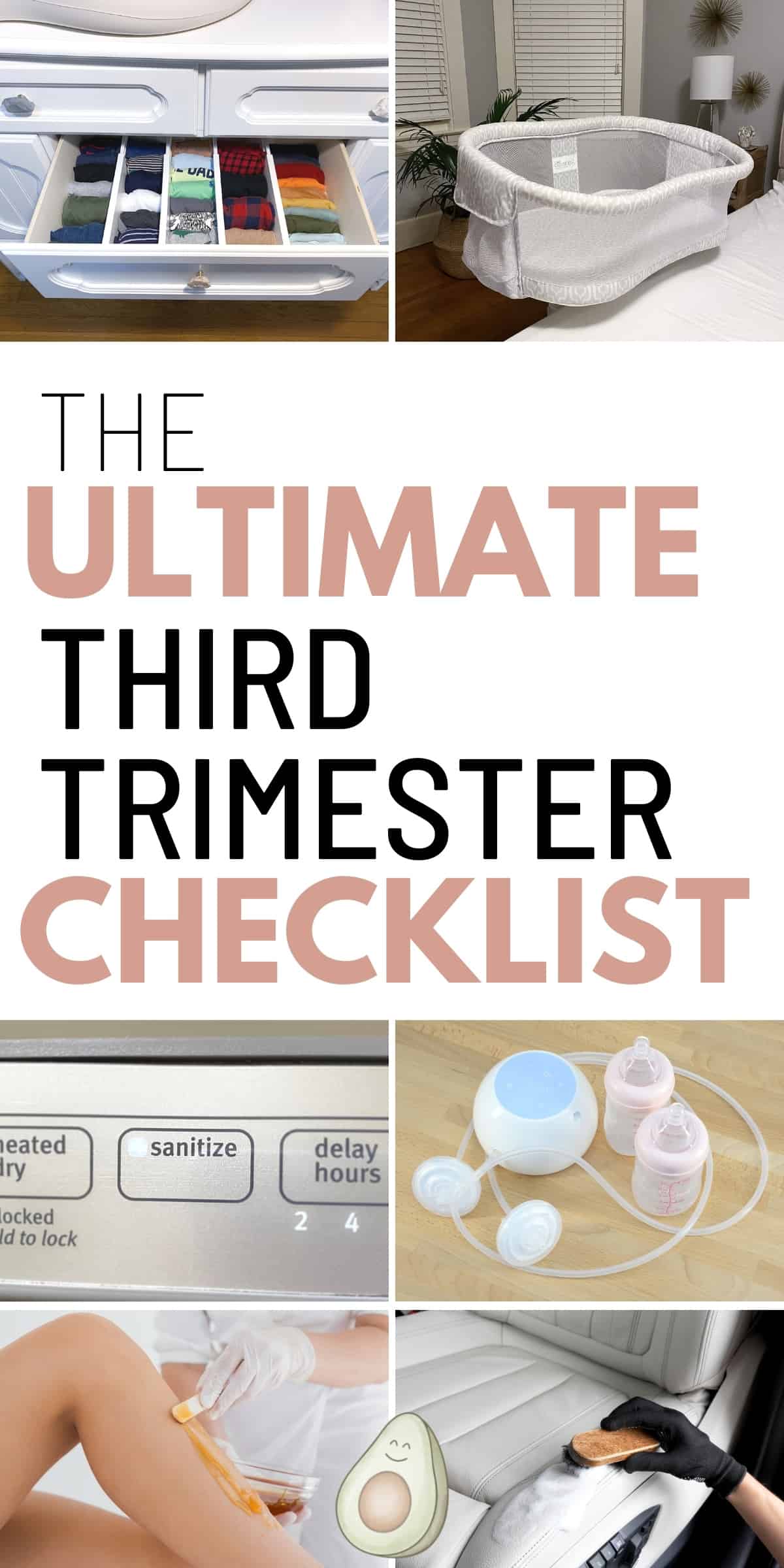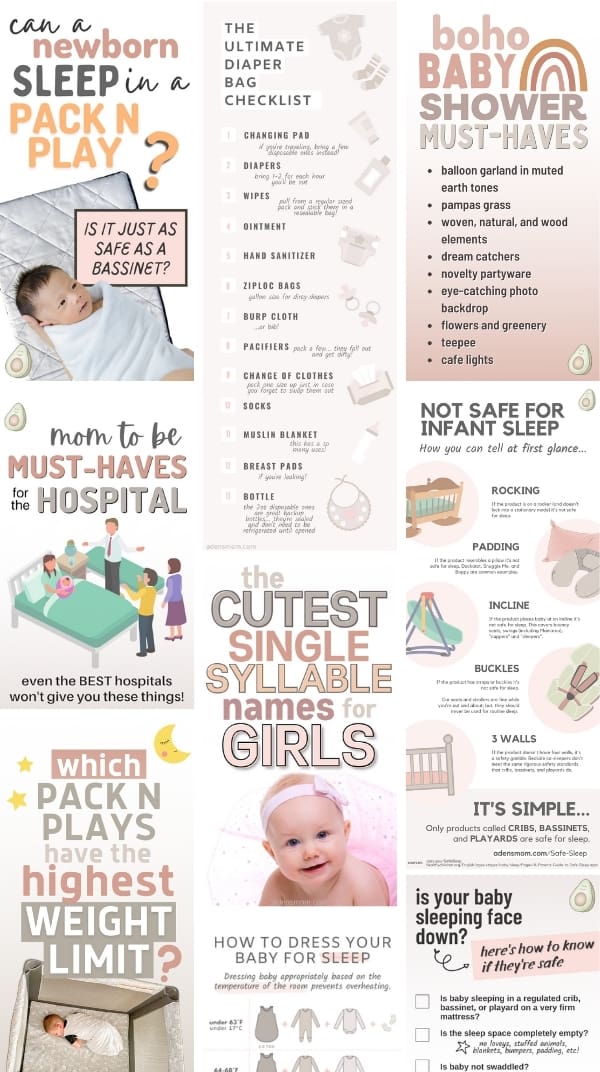Are you planning where your newborn will sleep and wondering how long you can use a bassinet?
Whether you’re currently expecting, or already in the thick of the 4th trimester, you’re probably wondering how long your baby can sleep in a bassinet and how to know when to switch to a crib.
What many people don’t realize is that there is no one-size-fits-all answer.
How long a baby can sleep in a bassinet is different for each bassinet model.
Not only that, but it’s going to be different for each baby based on how quickly they reach various milestones.
There are 3 handy charts (with sortable headings) in this post that will allow you to sort dozens of bassinets by weight limit. You’ll also be able to view the additional milestones dictated by their respective manufacturers.
Whether you already own a bassinet or are trying to figure out which one to buy, this should make it easy to find the information you’re looking for.
Let’s dive in!
Table of Contents
- How long can a baby sleep in a bassinet?
- Which bassinets can be used the longest?
- Are there other options that can be used even longer?
- How long should a baby sleep in a bassinet in mom and dad’s room?
- Then what? Where should baby sleep when he outgrows the bassinet?
- FAQs related to how long to use a bassinet
There may be affiliate links in this post. Read this disclosure policy to learn more.
PIN FOR LATER

How long can a baby sleep in a bassinet?
Most traditional bassinets can be used until your baby reaches 15lbs or starts pushing up on his hands and knees, whichever comes first. Many babies hit these milestones around 4 or 5 months.
A lot of the newer bassinets have higher weight limits…
There’s one bassinet with a whopping 33lb weight limit!
That said, a baby’s weight is just one of the factors that determine how long he can sleep in a bassinet.
Developing physical capabilities are the other part of the picture.
These are skills that make it increasingly possible for an infant to climb or fall out of a bassinet.
Manufacturers instruct parents to stop using their bassinet upon the first milestone that is reached, which can vary from product to product.
Related: Pack N Plays with the Highest Weight Limits

Examples of milestones that determine how long a baby can sleep in a bassinet:
- Able to push up on hands and knees
- Can roll over
- Able to sit unassisted
- Can pull up on sides
- Reaches age limit
- Reaches weight limit
Again, keep in mind that not all bassinets have the same milestones. Always follow the instructions in the user manual for the specific product that you own.

The chart below contains the milestones of popular bassinets with standard weight limits. Afterward, we’ll talk about your options for bassinets with higher weight limits.
Click on the pink plus sign to view the chart.
CHART: Bassinets with standard weight limits
Scroll to the right to view the full chart. Click any heading to sort.
Which bassinets can be used the longest?
After seeing how quickly a baby can outgrow a standard bassinet, you’re probably wondering if there are any bassinets with longer lifespans.
The good news is that there are several bassinets on the market that can hold a good deal more weight.
The bad news is that in most cases, the physical developmental milestones (such as pushing up on hands and knees) are the same.
If you’re looking for a bassinet with the potential for the greatest longevity, here are your options:
CHART: Bassinets with high weight limits
Scroll to the right to view the full chart. Click any heading to sort.
Are there other options that can be used even longer?
Indeed, there are!
There are several products on the market with adjustable features that can accommodate a growing baby.
These bassinets have mattress levels that can be lowered over time as your baby develops.
CHART: Bassinets that grow with your baby
Scroll to the right to view the full chart. Click any heading to sort.
How long should a baby sleep in a bassinet in mom and dad’s room?
The AAP encourages parents to share a room with their babies “for the first 6 months or, ideally, for the first year.”
Why?
“The AAP recommends room sharing because it can decrease the risk of SIDS by as much as 50% and is much safer than bed sharing.”
That said, room-sharing is considered an added protective factor against SIDS, not a foundational one.
If you are vigilantly practicing the ABC’s of safe sleep, there is already a negligible risk of sleep-related death.

If you choose not to room-share, you can still take advantage of the other protective factors which include breastfeeding (50% risk reduction of SIDS) and offering a pacifier before every sleep period (90% risk reduction).
Note that these protective factors do not stack.
Then what? Where should baby sleep when he outgrows the bassinet?
If your baby is too big for his bassinet—or if he’s met one of the developmental milestones—or if you’re just ready for him to sleep in his own room, your next step is graduating to a crib or a playard.
Here are some tips for getting started:
- Be sure to only use a product that is called a crib or playard. These are LEGAL terms that indicate that an infant sleep product meets federal safety standards. Related: Can a baby sleep in Pack N Play?
- Do not add any form of padding whatsoever to the sleep space. Any “hack” to make your baby more comfortable is unsafe. The crib or playard should be completely empty, with just a fitted sheet.
- Never attach bumpers to the crib. They aren’t necessary to prevent injury. Bumpers pose suffocation, strangulation, and entrapment hazards.
- If your baby knows how to roll over (or is showing signs of rolling), it’s time to stop swaddling and switch to a sleep sack.
- Do not allow your baby to sleep with a lovey in the crib. Soft objects are suffocation hazards.
- Since bedding is unsafe, use a sleep sack for warmth. A sleep sack is a wearable blanket.
- Hard items like frames, mirrors, and name signs should not be hung over a crib. (If you already have them and wish to keep them, pull the crib 1-foot away from the wall).
- Mobiles attached to the crib are safe until 5 months or when baby begins to push up, whichever happens first.
- Window treatments and window cords should not be within 3 feet of a crib.
If the transition from bassinet to crib is challenging, hang in there, it will 100% get easier!
P.S. If you don’t already use loud white noise to help your baby sleep, it’s a game-changer!
You may also like:
Snuggle Me Safety: The Evidence-Based Guide
This post answers questions such as:
- Is a lounger like Snuggle Me or Dockatot safe for infant sleep? — What if you’re watching?
- Is it safe to put a lounger in a crib or bassinet?
Read the article here.
Frequently asked questions (FAQs) related to how long to use a bassinet
Do I need a bassinet?
You don’t need a bassinet, but you do need a safe sleep space for your baby. Only bassinets, cribs, and playards meet federal safety standards for infant sleep.
Here are some types of products that do NOT meet CPSC standards for sleep:
- Dockatot, SnuggleMe, and any “nest”
- Any product intended to be placed in an adult’s bed
- Any “bedside sleeper” (bed with 3 sides)
- Anything with an incline such as a swing, lounger, or bouncy chair
Many families make the logical choice to forgo the bassinet due to its very limited window of use.
There is nothing wrong whatsoever with starting your baby off in a crib or Pack ‘n Play from day one.
Can a newborn sleep in a crib right away?
Yes! It’s safe to start using a crib when your baby is a newborn.
Cribs meet the highest level of safety standards for infant sleep. (So do bassinets and playards).
If you’d like to start getting your newborn used to a crib right off the bat, go for it! It’s one less transition to deal with later.
How long can a baby sleep in a cradle?
A baby can sleep in a cradle for approximately the first 5 months of life and until he is pushing up on hands and knees.
This varies from model to model, so it’s important to read the user manual that came with your product.
As always, be sure to stop using the cradle based on whichever milestone your baby reaches first.
Note: In order to be safe for sleep, cradles must meet CPSC standards.
Is there a bassinet age limit?
Parents often ask, “at what age should baby stop sleeping in bassinet?”
Some bassinets have official age limits. Others have approximate age recommendations. Some have no age guidelines at all (but other milestones).
Here are a few examples of bassinet age limit verbiage:
- MamaRoo Sleep: “Do not use the mamaRoo sleep™ once your child begins to show signs of being able to pull up, push up or sit unassisted, regardless of age or weight. Maximum weight: 25lb (11.3kg) Maximum age: 6 months.”
- Delta Sweet Beginnings: “For use from birth to 5 months or until your baby begins to push up on their hands and knees, whichever comes first.”
- Baby Bjorn: “Do not use this product when the infant begins to push up on hands and knees or has reached 8 kg/18 lb (approximately at 6 months), whichever comes first.”
Keep in mind, as we’ve already discussed in depth, how long a baby can sleep in a bassinet is determined by whichever milestone happens first.
It’s important to stop using a bassinet when ANY of the milestones listed in the manual are reached.
When should babies start sleeping in cribs?
- reaches 15 lbs (or the weight limit indicated in the manual)
- is able to push up on hands and knees
- is able to sit unassisted
- can roll over
- can pull up on sides
- is too tall to be comfortable
- turns 5 or 6 months old
Each bassinet model has its own milestones for safe use. You should stop using your bassinet based on whichever milestone happens first.
Be sure to follow the directions in your user manual.
There is no official time that babies should start sleeping in cribs, in part, because there is a safe alternative to a crib: namely, a Pack ‘n Play.
How long can a baby stay in a bassinet during a single sleep period?
Bassinets are safe sleep spaces. It’s perfectly fine for your baby to sleep through the night or take a long nap in a bassinet.
Provided that you are practicing safe sleep, there is no limit to how long a baby can sleep in a bassinet in this context.
Can baby sleep in bassinet if rolling over?
Rolling over is considered a milestone for certain bassinets, and not others.
Your bassinet manual will tell you whether it’s safe for your baby to continue to sleep in a bassinet once he knows how to roll over.
The charts in this post are likely to contain the information you need.
If not, and if you can’t find your manual, just google the name of the bassinet plus the word “manual” and it should come right up. (Double-check that it’s the correct one, of course!)
Here are two popular bassinets whose user manuals explicitly state to stop using the product when baby can roll:
Related: My Baby Can Roll Over… Now What? (The Evidence-Based Guide)
Final thoughts on every new parent’s question, “how long can a baby sleep in a bassinet?”
How long a baby can sleep in a bassinet is not black and white. Not only does it vary from product to product, but also from baby to baby.
For planning purposes, it’s reasonable to estimate that your baby will be able to sleep in their bassinet from anywhere between 2 and 5 months of age. Just be ready to pivot at any moment.
If your baby rolls over for the first time at 1 month old, for example, you’d have to stop using the HALO Bassinest and the Graco Move ‘n Soothe Bassinet, even if the baby is well below the weight limit.
Or, if your baby is able to pull up on the sides of any bassinet at 3 months old, you’d have to stop using it regardless of the baby’s size.
Here’s what’s most important:
Once you decide which bassinet to buy (or if you already own one), it’s critical to read the user manual and take note of when it’s time to stop using the product.
Take a picture with your phone and save it for easy reference.
You don’t want to forget what milestones to look out for.
It’s also a good idea to have a safe crib or playard all ready to go, ideally before the baby turns 2 months old. This way, if you have to unexpectedly stop using the bassinet, there will be no need to panic.
Share this post with a friend or family member!
Articles related to how long a baby should sleep in a bassinet:
- What NOT to Register for — and What to Register for Instead
- Pack N Play Mattress Safety (Is it safe to add a supplemental mattress to make the playard more comfortable?)
- 6 Best Portable Bassinets



 Follow on Pinterest
Follow on Pinterest